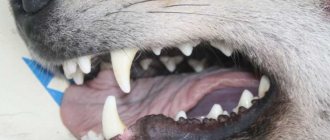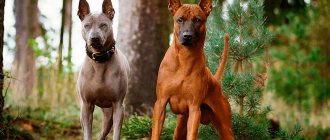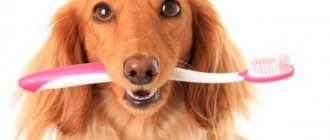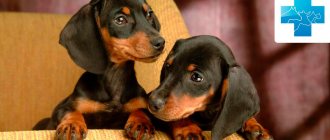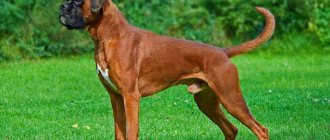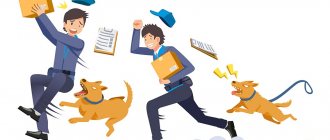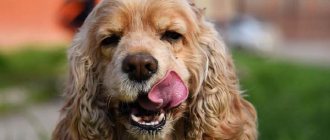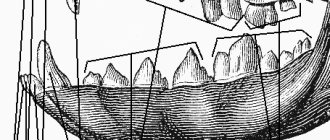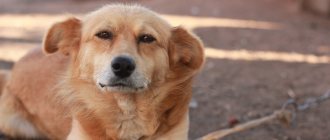Dog owners know that their pets have baby teeth at a young age, which are gradually replaced by permanent teeth. However, not every owner knows how many teeth a dog actually has. Therefore, it is recommended to study the structural features of animal jaws, to know exactly the quantity and methods of maintenance in order to ensure your pet a long and healthy life.
Not every owner knows how many teeth a dog has
Dog's dental system
The structure of a dog’s oral cavity plays a rather serious role. The life and condition of the pet depends on how it is developed. The dental system and bite play a role in the following cases:
- attack,
- protection,
- capture,
- retention,
- grinding and tearing food,
- finishing off prey.
This is why it is very important that the dog’s jaw is in perfect order. Otherwise, the pet’s quality of life is significantly reduced.
Number and location of teeth
The number of teeth may vary slightly depending on the type of dog. On average, the cavity contains 42 pieces. There are 20 pieces in the upper part, 22 on the lower jaw.
The arrangement of a dog’s teeth is conventionally divided as follows (if you mentally divide it in half):
- The upper part - 3 incisors, 1 canine, 4 false roots (premolars), 2 molars (molars) - in the left and right zone.
- The lower part is exactly the same, but there are more molars - 3 each.
You can consider the anatomy of the location in more detail in the diagram below.
The number and types of teeth should be almost the same in all breeds
The formula of the teeth of an adult dog represents
a total of 42 teeth, which means that in each half of both jaws there are three incisors, one canine and four false molars (premolars). In addition, in each half of the lower jaw there are 3 permanent molars, and in the upper jaw there are 2 molars. The first molar in the lower jaw and the premolar adjacent to the molar in the upper jaw are especially powerfully developed and are called carnivorous teeth.
*****************************
A dog's teeth are extremely strong formations of bone tissue. They serve to protect and attack, capture and hold, kill prey, tear off pieces of food, and crush bones. Each tooth consists of a dental crown, which protrudes above the gum and protrudes into the oral cavity, a tooth neck (the slightly narrowed part that the gum covers) and a tooth root, which is hidden in the alveolus (socket) of the jaw. At the top of the root there is a small hole that leads into the cavity of the tooth. This cavity consists of dental pulp - pulp, rich in blood vessels and nerves. The main mass of the tooth is dentin. The outside of the dentin crown of the tooth is covered with enamel, a very strong bone tissue, and the dentin of the tooth root is covered with cement. The periosteum of the tooth root and alveoli is common and is called periodontium. The dog has 12 incisors , 4 canines and 26 molars , for a total of 42 teeth . In the lower jaw, one pair of small molars may normally be absent, as they are vestigial. The canines are significantly longer than the incisors, located between the incisors and molars. One of the molars of each half of the jaw is especially large and is called carnassial. In connection with the change of teeth in a dog, a distinction is made between milk teeth and permanent teeth. In the dental formula, they are conventionally designated: milk teeth - with the letter D, permanent teeth - with the letter R. The change of teeth is considered, although unreasonably, to be a critical age, and at this time puppies allegedly become especially susceptible to the plague. In fact, in a properly raised puppy, the change of teeth occurs completely unnoticed. Sometimes in a set of teeth there are fewer teeth developed and then they speak of toothlessness (oligodontia), sometimes there are more teeth - polyodontia or hyperdontia. The dog must have a full set of teeth.
Diagram of a dog's complete set of teeth
1 - upper jaw 2 - lower jaw P - incisors K - canines P - small molars (premolars) M - large molars (molars) Depending on the location of the upper and lower teeth, dogs have different bites . Thus, mastiff dogs have a scissor bite. This is when a row of upper teeth covers the lower incisors, which are adjacent to the inner planes of the upper teeth. If the incisors of both jaws touch with their cutting edges, such a bite is called pincer-shaped. If the lower jaw is shorter and there is a gap between the rows of upper and lower incisors, then this will be called an undershot, and when the lower jaw, on the contrary, is longer than the upper, this is called an overbite or bulldog bite. Any deviation from the normal bite affects the dog’s working qualities, for example, it weakens the grip. Some show inspectors do not allow dogs with malocclusions into the ring. They are not involved in breeding work either, since any deviation from the normal bite is considered a congenital defect. However, there is also an acquired vice. During puppyhood, dogs love to pull or take away all sorts of objects. Inept owners allow them to do this with great effort and quite often, which is why the puppy’s bite changes. During the first year of life, this defect can be corrected. To do this, the following techniques are used: if the upper jaw is extended, while playing with the puppy, they force him to pull a leash hooked to the lower fangs, and if the lower jaw is extended, then the leash is hooked to the upper fangs. If this does not help, then an elastic band is put on the parallel fangs . Dogs have a hard time with this method; they try to remove the rubber band and require a lot of patience and perseverance from the owner. The gum is left on during the day and overnight. Take it off only when eating. In case of bleeding gums, the oral cavity is washed with a weak solution of potassium permanganate. If the malocclusion is not congenital, then it will certainly be corrected.
Dental bite in dogs
1. correct (scissor) bite 2. pincer bite 3. overshot 4. undershot In practical work, it is often necessary to determine the age of a dog by its teeth.
To do this you need to know the following. The puppy is born without teeth. His first teeth appear on days 20-25, and by the age of two months he has all his milk teeth. Their replacement with permanent ones occurs gradually and, as a rule, is completed by the age of ten months. By the age of one year, the dog has white teeth with sharp tubercles on the incisors. In the future, the age of the animal is determined by the erasure of the tubercles on the incisors and the grinding of the fangs. At the age of 2, the tubercles on the incisors of the lower jaw usually wear off, at the age of 3, the hooks on the incisors of the upper jaw, and at the age of 4, the tubercles on the middle incisors begin to wear off. At 5 years of age, the cusps of all incisors are absent. From the age of six, it is difficult to determine the age of a dog by its teeth, so it is necessary to estimate the age using other signs: general appearance, coat color, drooping lips, tartar deposits, etc. The teeth of a healthy dog do not require special attention from the owner. But sometimes plaque appears on them, which can cause caries, gum inflammation and other complications. Therefore, if you notice that your dog’s teeth have turned yellow, you need to stock up on a soft toothbrush, baby tooth powder or any toothpaste without a strong taste or smell. You need to brush your dog's teeth once or twice a week. Of course, not every dog will happily accept such an unnatural hygienic procedure for it, so we must try not to delay it and not cause the animal any unpleasant sensations. If your gums are still inflamed, you should not treat yourself; it is better to consult a veterinarian. As first aid, you can wipe the dog's teeth with a swab dipped in a warm pale pink solution of potassium permanganate Yfukzlyfz
***___________________________________________ *********************************************8888
swab the dog's teeth with
| Dog age | Time of appearance of teeth changing them, erasing them |
| Up to 3 weeks | No teeth. |
| 3 to 4 weeks | 4 fangs appear, first on the upper jaw, and after a few days on the lower jaw. |
| 4 to 5 weeks | 6 incisors appear. At 1 month of age, dogs usually have all their front teeth. |
| From 1 to 1.5 months | The first 2 molars appear. |
| From 1.5 to 2 months | The third molar appears. |
| From 2 to 4 months | Changing milk hooks to permanent ones. |
| From 3 to 5 months | The deciduous teeth are replaced by permanent ones, and the first molar appears in the lower jaw. |
| 4 to 6 months | The milky edges are replaced by permanent ones, the fourth molar appears (from 4 to 5 months), and the fifth molar appears from 5 to 6 months. |
| 6 to 7 months | The sixth molar appears. |
| From 7 to 14 months | Incisors with three teeth, pointed, white, no signs of wear yet. |
| At 15 months | The lower hooks are worn out. |
| At 2 years old | The lower holds are erased, the upper ones begin to compare. |
| From 2.5 to 3 years | The lower middle incisors are erased and the upper hooks are compared. |
| At 4 years old | The upper holds are erased and the middle ones are compared; the lower edges lose their teeth. |
| At 5 years old | All incisors are worn out. |
| By age 7 | The fangs begin to dull. |
| By 10–12 years | The crowns of all teeth are worn away. |
soaked in a warm pale pink solution of potassium permanganate.
How much should be normal?
The number of teeth may vary depending on the type and age of the dog.
In puppies
At birth, puppies are toothless; the incisors in the center grow when the baby is three weeks old. They are dairy:
- Between 4 and 6 weeks of age, the incisors grow.
- From 3 to 5 weeks, fangs can be seen.
- Premolars gradually grow in 5-6 weeks.
When a baby reaches two months of age, as a rule, he already has 28 teeth (14 on each jaw). During the teething period, the puppy needs help to reduce discomfort. It is best to give your baby specific toys to scratch his gums. This will help avoid damage to things in the house.
Molars in babies can be seen by the age of 4 months, and they are immediately permanent.
When changing, a gradual loss of milk occurs - the permanent ones force them out of their place. Initially, the incisors are replaced, then the canines and false roots. Attention! As a rule, by 7 months the dog has grown all 42 pieces.
If the sequence is violated, you must immediately visit a veterinarian. During replacement, immunity decreases, so at this time it is important to monitor the pet’s condition - provide a nutritious diet, and ensure that hypothermia does not occur. After complete replacement, repeated vaccinations are carried out.
In adult dogs
How many teeth does an adult dog have? All temporary ones are completely replaced by permanent ones by 7 months. From now on, she has 42 of them - 20 on the upper jaw and 22 on the lower jaw.
The life and development of your pet depends on the health of the oral cavity, so it is recommended to monitor its condition and take the necessary measures to eliminate problems in a timely manner.
Up to a certain age, puppies have milk teeth, which are then replaced by permanent ones.
Briefly about the main thing
- You need to take care of your dog's teeth from puppyhood.
- During the change of teeth, the puppy needs to be looked after especially carefully.
- An adult large breed dog should have 42 teeth. Shortage or excess is considered a deviation. Representatives of small and medium breeds are allowed a smaller number of teeth, which is not considered a defect.
- An adult dog's teeth should be looked after regularly by purchasing special bones to remove plaque from the teeth. Also, a number of breeds need to clean their jaws with special toothpastes created for dogs.
If you have questions or have an opinion on this topic, leave a comment after reading the article.
Special formula
A dog's dental formula is a special diagram that describes the location of teeth in the oral cavity of a furry dog. Letter and number combinations are used for this purpose.
As a rule, numbers indicate the number of teeth of a certain type, and letters indicate their variety. Below you can see common notations.
- I - incisors (Incisivi),
- C - fangs (Caninus),
- P - premolars (Praemolares),
- M - molars (Molares).
Therefore, the dental formula for the structure of a dog’s jaw looks like this:
- 2M 4P 1C 3I 3I 1C 4P 2M - upper jaw,
- 3M 4P 1C 3I 3I 1C 4P 3M - lower jaw.
Deviation from this formula is often considered a vice.
Prevention
Dog oral examination
The mucous membrane of a healthy dog is pink, shiny, without papillomas, and the gums should not show any signs of swelling. Teeth should be clean, free of brownish tartar and stuck food debris. A specific smell from the mouth is always present, but it should not be rotten or unpleasant. The surface of the tongue in normal condition is smooth and pink.
How to brush your dog's teeth
Brushing your teeth is the mechanical removal of plaque. Plaque is an accumulation of oral bacteria. After teeth erupt, their surfaces are immediately colonized by bacteria. Plaque quickly accumulates layers of mucus, and within two weeks the minerals begin to harden and form tartar. To brush your teeth, you will need a dog toothbrush (with short and not too hard bristles). There are no conclusive studies to suggest that dog toothpaste kills plaque-forming bacteria, so toothpaste is not necessary. Do not use human toothpastes as they contain ingredients that cause stomach upset or are toxic (due to fluoride). All teeth need to be brushed. If your dog is not at all enthusiastic about this procedure and you only have seconds and need to know where best to focus your efforts - try brushing the upper part of the canines, premolars and molars. Carefully pull back the jowls and insert the brush. The bristles should be at a 45 degree angle to the gum line, brushing back and forth along the teeth or in small circular movements. Simply smearing your teeth with dog toothpaste is completely pointless, since the main thing in this procedure is mechanical cleansing. If your dog really doesn't like a toothbrush, try a folded piece of bandage or gauze. Just like humans, dogs benefit from cleaning between their teeth with dental floss.
Nutrition
From an oral hygiene point of view, dry food is preferable to canned and natural food because it has some abrasive action that helps remove plaque from the crowns of teeth. Soft foods tend to lead to more plaque accumulation. Dry food is less common than canned food and natural food can get stuck between teeth and in gum crevices. However, even on dry food, plaque accumulates. As a preventative measure, give your dog special treats to clean his teeth.
Prevention of dental injuries
Dental injuries are especially dangerous in puppies and young dogs due to the fact that their teeth have not yet formed. First of all, the prevention of dental injuries is the elimination of inadequate loads on the dental system: it is strictly forbidden to throw stones at the dog. At dog games there should be no animals with strict collars, chains around their necks, or collars with spikes.
Types of teeth
Dogs grow several types of teeth. Each variety has characteristic features, description and purpose for the animal.
Incisors
There are 6 incisors on both jaws. However, some dogs may have both 7 and 8. This depends on the space between the canines. On the left and right sides of the line that can be used to divide the jaw into two equal parts, there are hooks. Then there are the middle ones, and after them the edges.
Attention! The incisors have a single root.
In adulthood, the number of teeth reaches 42.
Fangs
Fangs are long teeth that are cone-shaped and slightly curved outward. They are located between the incisors and premolars. They differ in one and quite powerful root. A dog of this type has 4 pieces - 2 on each jaw.
Molars, premolars in dogs
Premolars are located immediately behind the canines. Together with molars, they belong to the indigenous species. There should be 4 premolars; they are present on both jaws. After this are the molars.
In animals they immediately grow permanent and are located on both sides. There are 2 of them on the upper jaw, 3 on the lower jaw. They are necessary so that the dog can chew food thoroughly.
Problems
Toothaches and other dental diseases in dogs lead to physical discomfort for the pet, eating disorders, sleep disorders and stress. Therefore, regular monitoring by a veterinarian is mandatory to prevent unwanted consequences.
Raid
This problem occurs frequently and worsens with age: plaque can turn into tartar, which provokes inflammatory diseases of the oral cavity. The reason is improper feeding: lack of vegetables, fiber, and dietary fiber in food, which help natural cleansing. You can also give your pet special cookies. If plaque or stone still appears, you need to contact a veterinarian who will remove it.
Number by breed
Depending on the dog's breed, the number of teeth may also vary. For example, large animals - German Shepherds, Rottweilers, Staffords, Labradors - should have strictly 42 pieces. If there is any deviation, the dog is considered defective.
In dogs of medium and small breeds, the number of teeth can vary from 36 to 40 pieces. However, you can often find purebred spaniels or dachshunds in which the number reaches 42.
This volume cannot be found in small dogs due to changes that occurred during the breeding process. Toy terriers, chihuahuas, papillons, pugs are the happy owners of 36-38 pieces.
If the number of teeth is not normal
Unfortunately, the number of teeth in a dog may not always correspond to the norm. As a rule, there are several different reasons that can lead to this:
- During the change of baby teeth, it is recommended to carefully monitor this process. If they do not have time to fall out, then the permanent ones will grow above them. As a result, bite problems may develop. A similar problem often occurs in terriers - you can find dogs with double rows of teeth. This is caused by the carelessness of the owner. If the milk does not fall out on its own, then it needs to be removed.
- If the teeth are smaller than normal, then other reasons are possible. They can fall out due to improper nutrition - the dog does not have enough nutrients. Loss is caused by poor quality jaw care and lack of necessary load on the masticatory apparatus.
Attention! A dog can also lose teeth due to various diseases of the oral cavity or internal organs that arise as a result of heredity.
It is also worth remembering that the number of teeth a dog has changes with age, as does the canine skeleton. Gradually they begin to fall out.
The incisors are changed first
Appearance scheme
Chart of molars in dogs
Change in the appearance of molars:
- First, the animal loses its temporary incisors - the puppy is three to four months old.
- At six to seven months, the dog's fangs are replaced.
- With the fangs, all premolars fall out.
By nine months the process ends, and at the same time the dog’s radical bone formations appear.
Note. Representatives of small breeds are one to two months behind in terms of changes in the chewing apparatus.
Puppy's milk teeth
Small dogs live without teeth until the third or fourth week. Afterwards the temporary teeth erupt.
The appearance of milk teeth looks like this:
- Lower jaw: almost a mirror image of the upper.
- The dog's upper jaw: six incisors, two canines, six premolars - a total of fourteen teeth.
When is veterinary intervention required?
Dogs also have problems that may require dental assistance from a veterinarian. The most common diseases that you cannot cope with on your own:
- stomatitis - inflammation of the oral mucosa;
- pulpitis - the presence of purulent contents in the root canal;
- caries - damage to tooth enamel;
- periodontitis - damage to the tissue around the tooth;
- tartar - the appearance of hard deposits on the incisors and fangs.
Sometimes teeth can break. This happens as a result of injuries, bites from hard objects, strong pressure, or a lack of minerals in the diet.
Another problem is malocclusion. This condition occurs due to impaired tooth growth. Only a veterinarian can cope with such a problem; you cannot correct the bite yourself.
Fangs also gradually wear out, like other teeth
Gingivitis is an inflammatory process on the gums. The process causes animals a lot of unpleasant moments and suffering - the dog constantly whines and cannot eat normally. The causes of this problem may be changing teeth, the presence of tartar, allergic reactions, or lack of vitamins. Only a veterinary clinic can help your pet.
Attention! Constant dental care is important. It is necessary to accustom your pet to hygiene procedures from a young age. For cleaning you need to choose special toothpastes and brushes.
In addition, problems can be avoided if you periodically give your dog solid food - apples, carrots, bones, special cookies.
Healthy grin on a dog
The canine dental system is a mechanism made of durable bone tissue. With its help, the animal attacks and defends itself, captures prey and holds it, tears it into pieces and crushes bones.
Dogs show a grin when they feel threatened - they bare their fangs, wrinkle their nose, and look intently into the eyes of the enemy. And, if they are guilty, they stretch their lips very much. At the same time, they look away and whine quietly. In both cases, people see a grin from ear to ear. A healthy individual exhibits strong teeth.
Healthy grin
Already a one-year-old puppy has a full set of 42 permanent yellowish teeth. A deviation in one direction or another indicates a genetic mutation or poor intrauterine development of the fetus.
Note! As a dog ages, the dental crowns wear off and the canines wear down. But with the correct bite (closing of the jaws), this does not cause inconvenience to an older dog.
How to determine age by teeth
Many experts say that a dog's age can be determined by its teeth. Indeed, over time, the animal experiences a change in the appearance of its jaw:
- By the age of one and a half years, the front incisors on the lower jaw are worn down.
- The middle incisors on the lower ones begin to wear down by the age of two and a half years.
- At three and a half years old, the upper front incisors are ground down.
- At four and a half years, the process begins on the middle upper teeth.
- At five and a half years old, the lower outer incisors are ground down.
- At six and a half years old - the upper extreme incisors.
- By the age of eight, fangs begin to become dull.
- By the age of ten, the front incisors become oval, and by the age of twelve they may already fall out.
- Until the age of 16, as a rule, the remaining teeth fall out.
Attention! Depending on the conditions in which the animal is kept, the process of tooth wear and loss may occur faster or take a longer time.
Dogs' teeth develop gradually over several years.
To avoid rapid tooth wear, it is recommended to follow simple rules:
- monitor the development of the puppy’s bite,
- do not let your dog constantly chew hard objects,
- place the bowl in such a way that it does not damage your teeth while eating,
- monitor your pet's health,
- use special products for hygiene of the animal’s jaw.
Teeth are very important for a dog, so you need to carefully monitor their condition from a very young age. The puppy should be taught hygiene from a young age and the entire diet should be reviewed so that the animal has enough nutrients. If your pet begins to have problems with gums or teeth, you should consult a veterinarian in order to identify the disease in time and begin treatment.
Dog dental care
Knowing how many teeth on top and bottom the dog has in its mouth, the owner will be able to receive more information about his pet and properly care for him. Teeth, like a dog's coat, need regular cleaning.
In breeds with a regular bite, teeth cleaning occurs naturally while eating solid food.
Dog breeds with malocclusion require special care for their mouths after eating. In addition to special means of protection and care, you need to monitor your pet’s diet and what he likes to play with.
Balanced food is a source of nutrients for the animal. It does not allow pathogenic microflora to develop in the mouth by maintaining the animal’s immune system in good condition. You should also prevent your dog from chewing on stones or very hard objects that he uses to play on.
